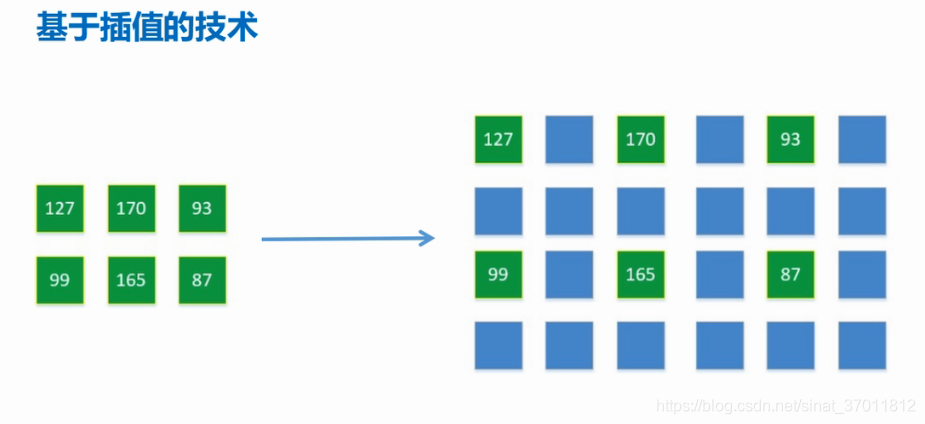OpenCV图像处理实战:从读取图片到显示图像的详细教程
发布时间: 2024-08-13 04:24:21 阅读量: 17 订阅数: 21 


# 1. OpenCV简介和图像处理基础**
OpenCV(Open Source Computer Vision Library)是一个开源的计算机视觉库,广泛应用于图像处理、计算机视觉和机器学习等领域。它提供了一系列图像处理和计算机视觉算法,可以帮助开发者快速高效地处理图像和视频数据。
图像处理是计算机视觉领域的基础,涉及对图像进行各种操作,包括图像读取、显示、转换、几何变换、滤波和分割。通过这些操作,我们可以增强图像质量、提取特征、分析图像内容,为后续的计算机视觉任务奠定基础。
# 2. OpenCV图像读取与显示
### 2.1 OpenCV图像读取操作
OpenCV提供了两种常用的函数来读取图像:`imread()`和`imdecode()`。
#### 2.1.1 imread()函数
`imread()`函数用于从文件或内存中读取图像。其语法如下:
```cpp
cv::Mat imread(const std::string& filename, int flags = 1);
```
其中:
- `filename`:图像文件的路径或内存地址。
- `flags`:指定图像读取标志,默认值为1,表示读取彩色图像。
**代码示例:**
```cpp
#include <opencv2/opencv.hpp>
int main() {
// 从文件中读取图像
cv::Mat image = cv::imread("image.jpg");
// 从内存中读取图像
std::vector<uchar> image_data = ...;
cv::Mat image = cv::imdecode(image_data, 1);
return 0;
}
```
#### 2.1.2 imdecode()函数
`imdecode()`函数用于从内存中解码图像。其语法如下:
```cpp
cv::Mat imdecode(const std::vector<uchar>& buf, int flags = 1);
```
其中:
- `buf`:包含图像数据的内存缓冲区。
- `flags`:指定图像解码标志,默认值为1,表示解码彩色图像。
**代码示例:**
```cpp
#include <opencv2/opencv.hpp>
int main() {
// 从内存中解码图像
std::vector<uchar> image_data = ...;
cv::Mat image = cv::imdecode(image_data, 1);
return 0;
}
```
### 2.2 OpenCV图像显示操作
OpenCV提供了两个函数来显示图像:`imshow()`和`waitKey()`。
#### 2.2.1 imshow()函数
`imshow()`函数用于在窗口中显示图像。其语法如下:
```cpp
void imshow(const std::string& winname, const cv::Mat& image);
```
其中:
- `winname`:窗口的名称。
- `image`:要显示的图像。
**代码示例:**
```cpp
#include <opencv2/opencv.hpp>
int main() {
cv::Mat image = cv::imread("image.jpg");
cv::imshow("Image", image);
return 0;
}
```
#### 2.2.2 waitKey()函数
`waitKey()`函数用于等待用户输入。其语法如下:
```cpp
int waitKey(int delay = 0);
```
其中:
- `delay`:等待用户输入的毫秒数,默认值为0,表示无限等待。
**代码示例:**
```cpp
#include <opencv2/opencv.hpp>
int main() {
cv::Mat image = cv::imread("image.jpg");
cv::imshow("Image", image);
cv::waitKey(0); // 等待用户按下任意键
return 0;
}
```
# 3. OpenCV图像基本操作
### 3.1 图像转换
#### 3.1.1 图像格式转换
OpenCV支持多种图像格式,包括常见的JPEG、PNG、BMP等。图像格式转换操作可以通过`cv2.imdecode()`和`cv2.imencode()`函数实现。
```python
# 读取图像并转换为灰度图
image = cv2.imread('image.jpg', cv2.IMREAD_GRAYSCALE)
# 将灰度图转换为彩色图
image_color = cv2.cvtColor(image, cv2.COLOR_GRAY2BGR)
# 将彩色图保存为PNG格式
cv2.imwrite('image_color.png', image_color)
```
#### 3.1.2 图像颜色空间转换
图像颜色空间转换是指将图像从一种颜色空间(如RGB)转换为另一种颜色空间(如HSV)。OpenCV提供了多种颜色空间转换函数,如`cv2.cvtColor()`。
```python
# 将RGB图像转换为HSV图像
hsv_image = cv2.cvtColor(image, cv2.COLOR_BGR2HSV)
# 从HSV图像中提取色调通道
hue_channel = hsv_image[:, :, 0]
# 显示色调通道
cv2.imshow('Hue Channel', hue_channel)
```
### 3.2 图像几何变换
#### 3.2.1 图像缩放
图像缩放操作可以改变图像的大小。OpenCV提供了`cv2.resize()`函数实现图像缩放。
```python
# 将图像缩小到一半
scaled_image = cv2.resize(image, (0, 0), fx=0.5, fy=0.5)
# 将图像放大两倍
scaled_image = cv2.resize(image, (0, 0), fx=2, fy=2)
```
#### 3.2.2 图像旋转
图像旋转操作可以将图像围绕指定中心旋转指定的角度。OpenCV提供了`cv2.getRotationMatrix2D()`和`cv2.warpAffine()`函数实现图像旋转。
```python
# 围绕图像中心旋转45度
rotation_matrix = cv2.getRotationMatrix2D((image.shape[1] // 2, image.shape[0] // 2), 45, 1)
rotated_image = cv2.warpAffine(image, rotation_matrix, (image.shape[1], image.shape[0]))
```
#### 3.2.3 图像透视变换
图像透视变换操作可以将图像从一个透视投影变换到另一个透视投影。OpenCV提供了`cv2.getPerspectiveTransform()`和`cv2.warpPerspective()`函数实现图像透视变换。
```python
# 定义透视变换矩阵
perspective_matrix = cv2.getPerspectiveTransform(np.array([[0, 0], [0, 1], [1, 0], [1, 1]]), np.array([[100, 100], [100, 200], [200, 100], [200, 200]]))
# 应用透视变换
transformed_image = cv2.warpPerspective(image, perspective_matrix, (image.shape[1], image.shape[0]))
```
# 4. OpenCV图像高级处理
### 4.1 图像滤波
图像滤波是图像处理中的基本操作,用于增强或去除图像中的特定特征。OpenCV提供了各种滤波器,包括平滑滤波、锐化滤波和形态学滤波。
#### 4.1.1 平滑滤波
平滑滤波用于去除图像中的噪声和模糊细节。常用的平滑滤波器包括:
- **均值滤波:**对图像中的每个像素计算周围像素的平均值,并用平均值替换原始像素。
- **高斯滤波:**类似于均值滤波,但使用高斯权重函数,权重随着与中心像素的距离增加而减小。
- **中值滤波:**对图像中的每个像素计算周围像素的中值,并用中值替换原始像素。
```python
import cv2
import numpy as np
# 读入图像
image = cv2.imread('image.jpg')
# 应用均值滤波
mean_filtered = cv2.blur(image, (5, 5))
# 应用高斯滤波
gaussian_filtered = cv2.GaussianBlur(image, (5, 5), 0)
# 应用中值滤波
median_filtered = cv2.medianBlur(image, 5)
# 显示滤波后的图像
cv2.imshow('Original Image', image)
cv2.imshow('Mean Filtered', mean_filtered)
cv2.imshow('Gaussian Filtered', gaussian_filtered)
cv2.imshow('Median Filtered', median_filtered)
cv2.waitKey(0)
cv2.destroyAllWindows()
```
#### 4.1.2 锐化滤波
锐化滤波用于增强图像中的边缘和细节。常用的锐化滤波器包括:
- **拉普拉斯算子:**计算图像中每个像素的二阶导数,突出边缘。
- **Sobel算子:**计算图像中每个像素的梯度,用于检测边缘方向。
- **Canny算子:**结合拉普拉斯算子和Sobel算子,用于检测图像中的边缘。
```python
import cv2
import numpy as np
# 读入图像
image = cv2.imread('image.jpg')
# 应用拉普拉斯算子
laplacian = cv2.Laplacian(image, cv2.CV_64F)
# 应用Sobel算子
sobelx = cv2.Sobel(image, cv2.CV_64F, 1, 0, ksize=5)
sobely = cv2.Sobel(image, cv2.CV_64F, 0, 1, ksize=5)
# 应用Canny算子
canny = cv2.Canny(image, 100, 200)
# 显示滤波后的图像
cv2.imshow('Original Image', image)
cv2.imshow('Laplacian', laplacian)
cv2.imshow('Sobel X', sobelx)
cv2.imshow('Sobel Y', sobely)
cv2.imshow('Canny', canny)
cv2.waitKey(0)
cv2.destroyAllWindows()
```
#### 4.1.3 形态学滤波
形态学滤波用于处理图像中的形状和结构。常用的形态学滤波器包括:
- **腐蚀:**缩小图像中的对象,去除噪声和细小细节。
- **膨胀:**扩大图像中的对象,填充孔洞和连接断开的区域。
- **开运算:**先腐蚀后膨胀,去除噪声并保留较大的对象。
- **闭运算:**先膨胀后腐蚀,填充孔洞并连接断开的区域。
```python
import cv2
import numpy as np
# 读入图像
image = cv2.imread('image.jpg')
# 创建形态学内核
kernel = np.ones((5, 5), np.uint8)
# 应用腐蚀
eroded = cv2.erode(image, kernel)
# 应用膨胀
dilated = cv2.dilate(image, kernel)
# 应用开运算
opened = cv2.morphologyEx(image, cv2.MORPH_OPEN, kernel)
# 应用闭运算
closed = cv2.morphologyEx(image, cv2.MORPH_CLOSE, kernel)
# 显示滤波后的图像
cv2.imshow('Original Image', image)
cv2.imshow('Eroded', eroded)
cv2.imshow('Dilated', dilated)
cv2.imshow('Opened', opened)
cv2.imshow('Closed', closed)
cv2.waitKey(0)
cv2.destroyAllWindows()
```
### 4.2 图像分割
图像分割是将图像分解为不同区域或对象的过程。OpenCV提供了各种分割算法,包括阈值分割、区域生长分割和边缘检测。
#### 4.2.1 阈值分割
阈值分割根据像素值将图像分为前景和背景。常用的阈值分割方法包括:
- **全局阈值分割:**使用单个阈值将整个图像分割为两部分。
- **局部阈值分割:**根据图像不同区域的局部信息使用不同的阈值。
- **自适应阈值分割:**根据图像的局部直方图计算阈值。
```python
import cv2
import numpy as np
# 读入图像
image = cv2.imread('image.jpg')
# 应用全局阈值分割
ret, thresh1 = cv2.threshold(image, 127, 255, cv2.THRESH_BINARY)
# 应用局部阈值分割
thresh2 = cv2.adaptiveThreshold(image, 255, cv2.ADAPTIVE_THRESH_MEAN_C, cv2.THRESH_BINARY, 11, 2)
# 应用自适应阈值分割
thresh3 = cv2.adaptiveThreshold(image, 255, cv2.ADAPTIVE_THRESH_GAUSSIAN_C, cv2.THRESH_BINARY, 11, 2)
# 显示分割后的图像
cv2.imshow('Original Image', image)
cv2.imshow('Global Threshold', thresh1)
cv2.imshow('Local Threshold', thresh2)
cv2.imshow('Adaptive Threshold', thresh3)
cv2.waitKey(0)
cv2.destroyAllWindows()
```
#### 4.2.2 区域生长分割
区域生长分割从种子点开始,将具有相似特性的像素分组为区域。常用的区域生长分割算法包括:
- **区域生长:**从种子点开始,逐像素地扩展区域,直到达到停止条件。
- **分水岭算法:**将图像视为地形,种子点视为水源,并使用分水岭算法将图像分割为不同区域。
```python
import cv2
import numpy as np
# 读入图像
image = cv2.imread('image.jpg')
# 设置种子点
seeds = np.array([[100, 100], [200, 200], [300, 300]])
# 应用区域生长分割
segmented = cv2.watershed(image, seeds)
# 显示分割后的图像
cv2.imshow('Original Image', image)
cv2.imshow('Segmented Image', segmented)
cv2.waitKey(0)
cv2.destroyAllWindows()
```
#### 4.2.3 边缘检测
边缘检测用于检测图像中像素值发生突变的位置。常用的边缘检测算法包括:
- **Canny算子:**结合高斯滤波和Sobel算子,用于检测图像中的强边缘。
- **Sobel算子:**计算图像中每个像素的梯度,用于检测边缘方向。
- **拉普拉斯算子:**计算图像中每个像素的二阶导数,突出边缘。
```python
import cv2
import numpy as np
# 读入图像
image = cv2.imread('image.jpg')
# 应用Canny算子
edges = cv2.Canny(image, 100, 200)
# 应用Sobel算子
sobelx = cv2.Sobel(image, cv2.CV_64F, 1, 0, ksize=5)
sobely = cv2.Sobel(image, cv2.CV_64F, 0, 1, ksize=5)
# 应用拉普拉斯算子
laplacian = cv2.Laplacian(image, cv2.CV_64F)
# 显示边缘检测后的图像
cv2.imshow('Original Image', image)
cv2.imshow('Canny Edges', edges)
cv2.imshow('Sobel X', sobelx)
cv2.imshow('Sobel Y', sobely)
cv2.imshow('Laplacian', laplacian)
cv2.waitKey(0)
cv2.destroyAllWindows()
```
# 5. OpenCV图像处理实战应用**
**5.1 图像增强**
图像增强是图像处理中一项重要的技术,其目的是改善图像的视觉效果,使其更适合于后续处理或分析。OpenCV提供了丰富的图像增强函数,可以满足各种增强需求。
**5.1.1 图像对比度和亮度调整**
图像对比度和亮度是影响图像视觉效果的重要因素。OpenCV提供了`cv2.convertScaleAbs()`函数来调整图像的对比度和亮度。该函数接收三个参数:
- 输入图像
- 对比度调整因子
- 亮度调整因子
例如,以下代码将图像的对比度增加一倍,亮度增加50:
```python
import cv2
# 读取图像
image = cv2.imread('image.jpg')
# 调整对比度和亮度
enhanced_image = cv2.convertScaleAbs(image, 2.0, 50)
# 显示增强后的图像
cv2.imshow('Enhanced Image', enhanced_image)
cv2.waitKey(0)
cv2.destroyAllWindows()
```
**5.1.2 图像锐化和去噪**
图像锐化和去噪是图像增强中的两个常见操作。OpenCV提供了多种滤波器来实现这些操作。
**图像锐化**
图像锐化可以增强图像的边缘和细节。OpenCV提供了`cv2.Laplacian()`和`cv2.Sobel()`等锐化滤波器。
例如,以下代码使用拉普拉斯算子锐化图像:
```python
import cv2
# 读取图像
image = cv2.imread('image.jpg')
# 锐化图像
sharpened_image = cv2.Laplacian(image, cv2.CV_64F)
# 显示锐化后的图像
cv2.imshow('Sharpened Image', sharpened_image)
cv2.waitKey(0)
cv2.destroyAllWindows()
```
**图像去噪**
图像去噪可以去除图像中的噪声,提高图像的清晰度。OpenCV提供了`cv2.GaussianBlur()`和`cv2.medianBlur()`等去噪滤波器。
例如,以下代码使用高斯滤波器去噪图像:
```python
import cv2
# 读取图像
image = cv2.imread('image.jpg')
# 去噪图像
denoised_image = cv2.GaussianBlur(image, (5, 5), 0)
# 显示去噪后的图像
cv2.imshow('Denoised Image', denoised_image)
cv2.waitKey(0)
cv2.destroyAllWindows()
```
0
0





